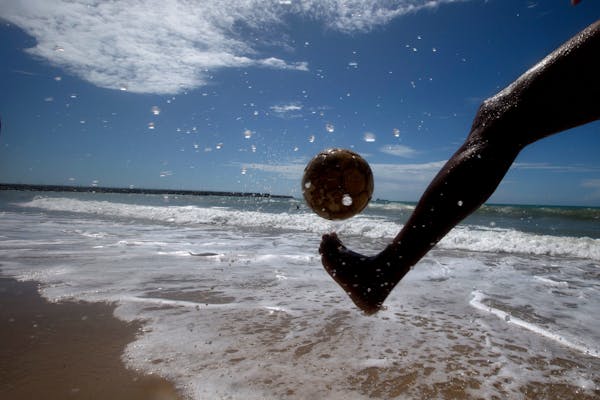A dozen years ago, local bars had to lure customers to early morning soccer telecasts with the promise of a free breakfast.
Complimentary coffee and muffins are no longer required. When it comes to the World Cup, the international tournament that kicks off Thursday, we're no longer on the sidelines.
The final at the last World Cup, which takes place every four years, drew 25 million U.S. television viewers, a whopping 41 percent increase from 2006. That's more than the number of people who tuned in for Game 6 of the 2013 World Series.
Expect the turnout to be even greater this time around because matches will be taking place in time-zone-friendly Brazil, which means many of the key games will happen during happy hour.
"You don't have to sneak out of work and then go back to work," said Alexi Lalas, a member of the National Soccer Hall of Fame and ESPN's lead analyst. "You can go to the bar, drink and keep drinking, which is a huge part of soccer."
Tippling aside, we've come a long way since the time a World Cup qualifying match at a Minneapolis pub was interrupted by a band playing underneath the screen, or when the owner of a St. Paul restaurant showed his hatred for the game by disconnecting the cable right before a critical World Cup match.
"The passion fans have now is so radically different from the past," said Bruce McGuire, host of the podcast "du Nord Futbol" and editor of a local soccer blog. "This is what I dreamed of my whole life."
We're simply catching up with the rest of the world. The FIFA World Cup is the world's most viewed sporting event, with the 2010 final drawing 715.1 million fans. This year's Super Bowl was the most-watched in history — with a measly 115 million viewers.
Immigrants streaming in from Latin America, Asia and Africa are bringing their love of the game with them. According to Metropolitan Council analysis, we are in a 50-year period (1990-2040) in which the seven-county metro area will gain almost 750,000 immigrants.
"You can see 10 times more interest than eight years ago," said Atlas Grill chef/owner Abbas Shahbazi, who will be rooting for his native Iran. "In Northeast it's huge, on Lake Street it's huge. We are expecting a lot of people to watch at [sister restaurants] Tavern on France and Tavern in Blaine. Soccer is getting huge in Minnesota."
Young people are also helping to lead the way. Men's Journal notes that soccer is currently the second most popular sport in the U.S. among 12- to 24-year-olds, and the Pew Research Center discovered that 40 percent of those age 18 to 29 are looking forward to the World Cup.
"The biggest thing is that we have a lot of kids who have grown up with it. They've loved it their whole life," McGuire said. "In high school, the soccer kids are not the oddballs anymore. They're like the other athletes. They don't care about race or color. They feel the same way about soccer. 'I just like what I like.' "
No one is more keenly aware of the growing interest in the game than TV executives. A major reason: Advertising on soccer telecasts grew 43 percent from 2010 to 2013.
Fox shelled out $425 million to have exclusive U.S. rights for the next two World Cups. ESPN, which is finishing up the second of a $100 million two-tourney contract, is going all out this year with at least 32 cameras at every match and analysts from 12 countries. Jed Drake, ESPN's senior vice president, said the network's coverage of the South Africa games marked a turning point.
"One of the things we learned in 2010 was that we could finally break through in this country," he said. "We treated it with the same sort of intrigue and interest that the rest of the world does. That was a great achievement."
Peter Yamashiro, a Minneapolis mental-health worker and rabid fan, remembers when American announcers kept comparing every player to those in other sports, as if audiences would be lost without some sort of analogy.
Not anymore.
"We're not dumbing it down," Lalas said. "Having seen the progression and evolution of the way we talk about soccer, I no longer have to be up there explaining what a 'throw-in' is. I'll slow the bus down a little bit, but you've got to jump on. Once you do, you'll learn very, very quickly and be part of one of the greatest parties you've ever seen."
The bash could be explosive if the U.S. team defies the odds and manages to make its way to the final. If that "do you believe in miracles" moment happens, Men's Journal estimates that 50 million patriots could be glued to the set.
Don't bet on it, said John Cosgrove, who will provide his snarky thoughts on KTWN, 96.3 FM.
"The U.S. team is like the little cousins that come and visit on Sunday," he said. "You tolerate them and then shoo them away."
ESPN isn't terribly worried about an early departure for the Americans. Ratings barely took a hit in 2010 when the U.S. squad went out in the round of 16.
"We're different than, say, England, where everybody hangs their hat on their team. When they go out, it's going to be like the end of the world," Drake said. "Viewers in our country have secondary teams and tertiary teams. That's part of the fun of this thing. If the U.S. does get knocked out, so be it. On we go."
Neal Justin • 612-673-7431
Bill Ward • 612-673-7643
Has Salman Rushdie changed after his stabbing? Well, he feels about 25, the author tells AP
Heart, the band that proved women could rock hard, reunite for a world tour and a new song

Dick Van Dyke earns historic Daytime Emmy nomination at age 98

Sound Advice: Stick with what works for you

